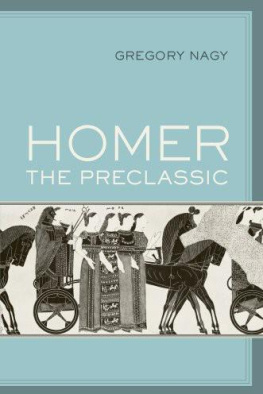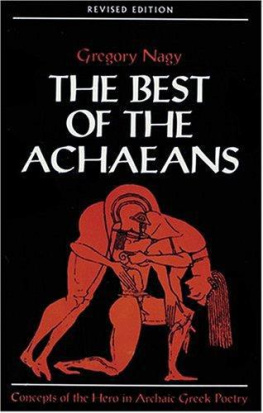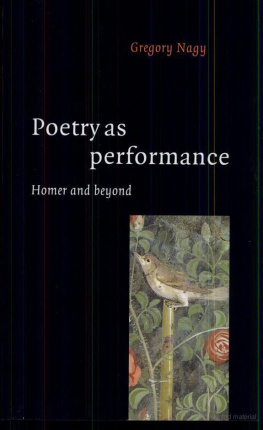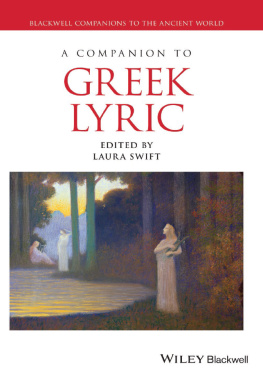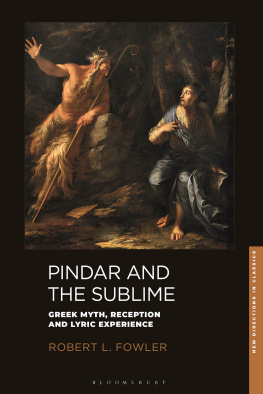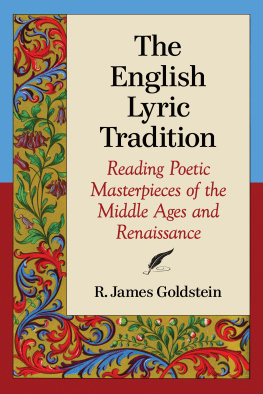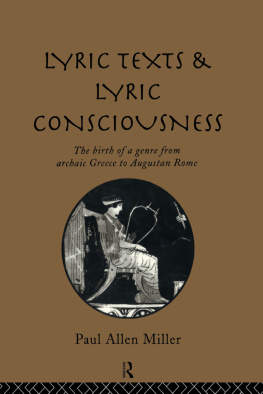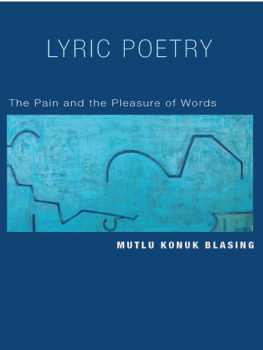Appendix
A Comparative Survey of Pindar's Meters
A fundamental type of colon in the system of Aeolic meters is the so-called glyconic:
xx_oo_o_=
glyc3. The glyconic can be internally expanded by a unit called thechoriamb
oo_=
ch This expansion may involve one, two, or three choriambs, to formxx_oo__oo_o_=
glyc@ch xx_oo__oo__oo_o_=
glyc@2ch xx_oo__oo__oo__oo_o_=
glyc@3ch Similarly a glyconic can be internally expanded by a unit called adactyl_oo=
da This expansion may involve one or two dactyls, to formxx_oo_oo_o_=
glyc@da xx_oo_oo_oo_o_=
glyc@2da Now the glyconicxx_oo_o_=
glyc has a catalectic variant, called the
pherecraticxx_oo__=
pher.
By
catalectic and
catalexis, I mean the shortening of the metricalunit by way of deleting the last syllable and making the next-to-lastsyllable the new
brevis in longo. Using the symbol < forcatalexis, I describe the pherecratic as a catalectic glyconic:
pher =
glyc<. Like the glyconic, the pherecratic can be expanded by choriambs:xx_oo__oo__oo__=
pher@2ch Like the glyconic, the pherecratic can be expanded by dactyls:xx_oo_oo__=
pher@da xx_oo_oo_oo__=
pher@2da xx_oo_oo_oo_oo__=
pher@3da.
x_oo_o_=
>glyc =
tele x_oo__=
>pher =
reiz These acephalic variants, the telesillean and the reizianum, can inturn be internally expanded by choriambs or dactyls, as inx_oo__oo_o_=
>glyc@ch =
tele@ch x_oo_oo__=
>pher@da =
reiz@da.
6. Let us take a closer look at the relationship between the Greekiambic dimeter and trimeter:
x_o_x_o_=
ia&IA iambic dimeter
x_o_x|_o _x_o_=
ia+iaIA iambic trimeter
x_o_x _o|_x_o_=
ia&IA+IAiambic trimeter
In this scheme the abbreviation
ia stands for the iamb, x_o_,in the first four syllables, or opening, of an iambic dimeter, while
IA stands for the iamb, x_o_, in the last four syllables, orclosing. The sign | stands for word break, that is, word boundary,while & stands for a combination not marked by any particularpattern of word breaking. The sign + stands for the additionof an extra opening (
ia) or closing (
IA).
7. Not only iambic trimeter but also other trimeters contain constituents that are cognate with dimeters otherthan the iambic dimeter. For example, the element ia can combine with adimeter shaped glyc, and here again we can observe thepattern 5|7 as an outcome:
x_o_x|x_oo_o_=
ia+glyc the 5|7 pattern is a constant in Classical iambic trimeters shaped
ia+ia&IA, but it is only a tendency in archaic trimeters shaped
ia+glyc. We can apply an analogous formulation to the 7|5pattern in Classical iambic trimeters shaped
ia&IA+IA: againwe see a constant, as distinct from a correspondingtendency in archaic trimeters shaped
glyc+IA:xx_oo_o|_x_o_=
glyc+IA8. So far we have considered various patterns of reapplied opening andreapplied closing. But there are also situations where the openingand the closing are inverted, that is, where a closing is fused with anopening that follows. For an illustration, let us examine what canhappen when two glyconics are run together:
xx_oo_o__|x_oo_o_=
glyc~glyc this process is analogous to the synchronic pattern 5|7 of iambictrimeter:x_o_x|_o_x_o_=
ia+ia&IA9. Let us now turn from the Aeolic meters to the so-calleddactylo-epitrite meters, the second of the two major metrical groupings that Ihave undertaken to survey. A basic unit of the dactylo-epitritemeters is the so-called prosodiakon:
x_oo_oo_=
pros The
pros behaves like a constituent of trimeter. Let uscompare the pattern traditionally known as the
iambelegos:x_o_x|_oo_oo_=
ia+pros with an iambic trimeter that has a word break after syllable 5:x_o_x|_o_x_o_=
ia+ia&IA and with the trimeter formed with a glyconic, again featuring wordbreak after syllable 5:x_o_x|x_oo_o_=
ia+glyc10. On the basis of such formal parallelisms in trimeter-formation, Ipropose that the prosodiakon (pros) is an offshoot of the Indo-European dimeter, justlike the iambic dimeter and various otheroctosyllabic meters that are attested in Greek lyric:
x_o_x_o_= iambic dimeter (
ia&IA)
xx_oo_o_= glyconic (
glyc)
derived from a reconstructed typexxxxo_o_= "irregular glyconic"
Likewise,x_oo_oo_= prosodiakon (
pros)
derived from a reconstructed typexxxx_oo_
as attested in the typexx_x_oo_= choriambic dimeter.
So also with the prosodiakon (
pros): we could say that it is aregularization of the choriambic dimeter, with the fifth-to-last andsixth-to-last syllables generalized as two shorts, forcing theseventh-to-last to be generalized as a long to avoid a sequence of three shorts.What results is the symmetry of a rhythmical sequence_oo_oo,
framed at each end by one syllable of indifferent quantity (x).
11. Besides the various types of Greek dimeter that we havealready seen resulting from various patterns of rhythmicalgeneralization, I now list the following additional types:
_o_x_o__= trochaic dimeter (
tr&TR)
_o_o_oo_= trochaic-choriambic dimeter (
tr'&CH)
_oo_o_o_= choriambic-iambic dimeter (
CH&ia')
oo_o__ = aristophanean (catalectic of above)
x_oo_o__= hagesichorean (
hage)
13. This much said, the diachronic perspective can help us reducethe proliferation of categories in Greek lyric. Let us begin byconsidering again the glyconic (glyc) and its closest relatives:
A xx_oo_o_= glyconic(
glyc)
B xx_oo_o__ = hipponactean (
hipp)
C x_oo_o_= telesillean (
tele)
D x_oo_o__ = hagesichorean (
hage)
From the synchronic viewpoint of descriptive metrics, we maydescribe segments B, C, and D as derivatives of A: B byhypersyllabism, C by acephaly, and D by both acephaly andhypersyllabism. The diachronic point of view, however, is moresubtle. First of all, let us observe that a 7-syllable unit like C is aninherited variant of A: the comparative evidence of Indic metershows that dimeters could be 7-syllable as well as 8-syllable units,with matching rhythm in the closing.Another example is the type_m_oo_o__,
attested as a functioning variant of the type_m_oo_oo_
in compositions attributed to Alcman.
14. In light of this diachronic perspective, let us reconsider the processof dovetailing. For illustration, I turn to our earlier example of twodovetailing glyconics:
xx_oo_o__|x_oo_o_=
glyc~glyc.
In synchronic terms dovetailing happens when the wordbreak is skipped at the end of one metrical unit and transferred tothe position after the first syllable of the following metrical unit. Indiachronic terms, however, what is needed to achieve such a processof dovetailing is the
systematic juxtaposition of phraseologythat is rhythmically shaped
hipp with phraseology that isrhythmically shaped
tele in order to achieve an overallrhythmical effect that we may still describe synchronically as
glyc~glyc. In diachronic terms, then, dovetailing can evolveonly in situations where the traditional repertoire features aplurality of rigid meters that allow the perception of synchronicderivation, one from the other, by way of acephaly orhypersyllabism or both. From the standpoint of the Aeolic tradition,phrases shaped
hipp and
tele are functional variants ofphrases shaped
glyc by the very fact that they aretraditionally combined to produce the sound-effect of double
glyc. For this reason, we may in a given situation designate a
hipp as
glyc~ and a
tele as
~glyc, providedthat we have reason to think that the given phraseological repertorygrew out of a


